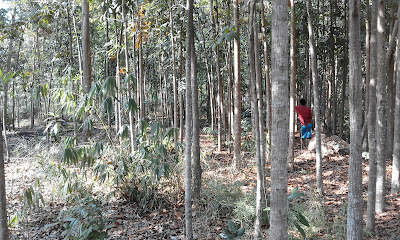Those that are at least 8 inches dbh and are harvestable are numbered 01 to 80+, as of last Saturday, March 19 when I visited the farm. Those that are 5-8 inches dbh are numbered 101 to 580+ as of last Saturday.
There are tens of thousands of trees in the farm, mostly mahogany in the lowland, followed by gmelina in the upland, then some eucalyptus, acacia auri and acacia mangium, narra. There are many local and endemic species like molave, karael, etc.
These are planted mahogany trees about 7-8 years ago perhaps. They are standing on rocky soil so they cannot grow fast and big but they are able to survive and thrive.
No big and mature tree that produce seeds yet, so there are no naturally growing trees yet and hence, the spacing is maintained. Once a big tree will produce seeds and scatter them, this area will look "chaotic" with thousands of new saplings growing every year in between those bigger trees.
The old canal that diverted part of the water in the creek into the other side, via a small dam and 3 hoses.
When trees of different ages grow, they look like this. This is between the well-spaced trees above, and the rice field near my treehouse.
--------------
See also:
Trees in the Farm, Part 3, February 11, 2013Trees in the farm, Part 4, June 23, 2015
Trees in the farm, Part 5, October 13, 2015








No comments:
Post a Comment